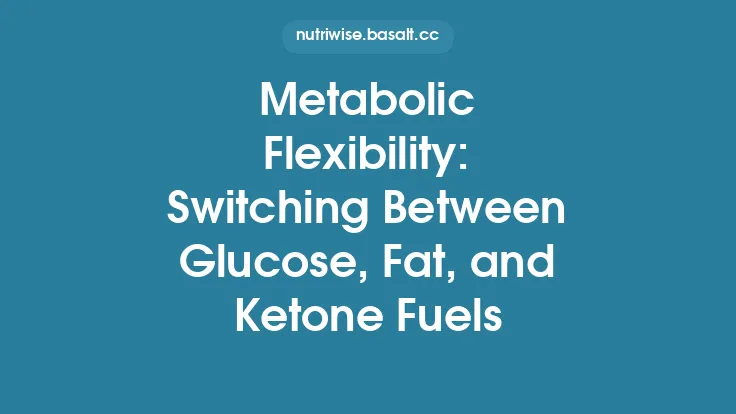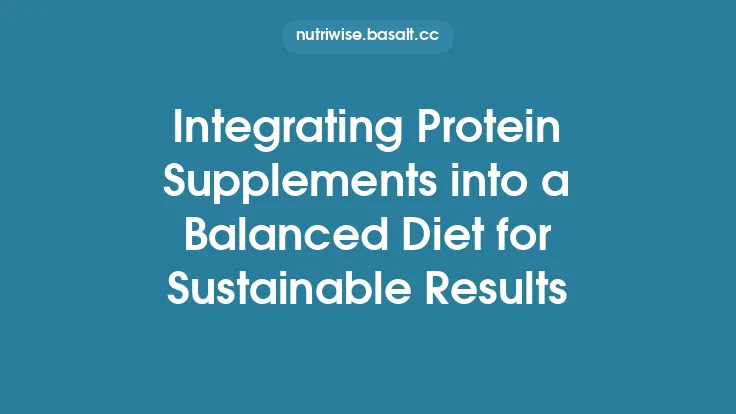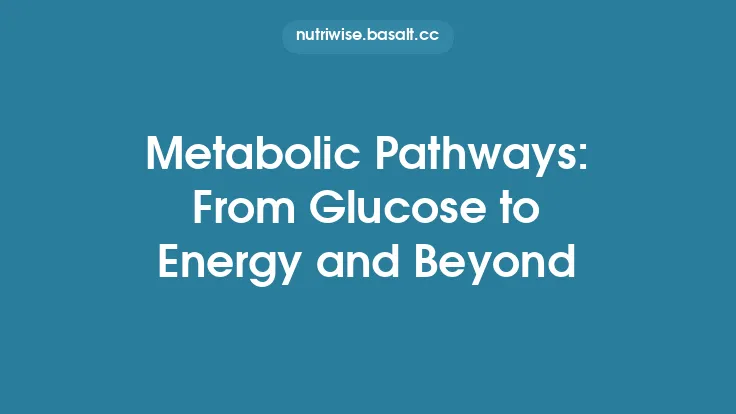Metabolic flexibility refers to the body’s capacity to adjust its fuel oxidation pathways in response to the availability of different macronutrients. Rather than being locked into a single substrate—such as glucose after a carbohydrate‑rich meal or fatty acids during prolonged fasting—the metabolically flexible organism can seamlessly shift between carbohydrates, fats, and, when necessary, proteins to meet energetic demands. This adaptability is a cornerstone of efficient energy utilization, supports optimal performance across a range of physical activities, and helps protect against metabolic dysregulation that underlies many chronic diseases.
Defining Metabolic Flexibility
At its core, metabolic flexibility is a dynamic property of cells, tissues, and whole‑body physiology. It can be broken down into three interrelated components:
- Substrate Availability Sensing – Cellular sensors detect circulating concentrations of glucose, free fatty acids (FFAs), and amino acids, as well as intracellular pools such as glycogen and intramyocellular lipids.
- Enzymatic Responsiveness – Key metabolic enzymes (e.g., pyruvate dehydrogenase, carnitine palmitoyltransferase‑1, and branched‑chain α‑ketoacid dehydrogenase) are modulated by allosteric effectors, covalent modifications, and changes in gene expression, allowing rapid up‑ or down‑regulation of specific pathways.
- Mitochondrial Capacity – The mitochondrion’s ability to oxidize both carbohydrate‑derived pyruvate and fatty‑acid‑derived acetyl‑CoA determines the ceiling for substrate switching. Mitochondrial biogenesis, inner‑membrane remodeling, and the composition of electron‑transport chain (ETC) supercomplexes all contribute to this capacity.
When these components operate in concert, the organism can, for example, oxidize a high proportion of glucose after a carbohydrate‑rich meal, then transition to predominant fat oxidation during a low‑carbohydrate diet or after an overnight fast, without a loss in ATP production efficiency.
Cellular Mechanisms Underlying Substrate Switching
1. Allosteric Regulation of Key Gatekeepers
- Pyruvate Dehydrogenase Complex (PDC) – Converts pyruvate to acetyl‑CoA, linking glycolysis to the TCA cycle. High ratios of NADH/NAD⁺ and acetyl‑CoA/CoA inhibit PDC, favoring fatty‑acid oxidation. Conversely, elevated ADP and low acetyl‑CoA activate PDC, promoting carbohydrate oxidation.
- Carnitine Palmitoyltransferase‑1 (CPT‑1) – Controls entry of long‑chain fatty acids into mitochondria. Malonyl‑CoA, a product of acetyl‑CoA carboxylase, is a potent inhibitor; its concentration falls during fasting or low‑carbohydrate intake, relieving inhibition and enhancing fat oxidation.
- AMP‑Activated Protein Kinase (AMPK) – Senses cellular energy status (high AMP/ATP). When activated, AMPK phosphorylates and inhibits acetyl‑CoA carboxylase, reducing malonyl‑CoA and thereby stimulating CPT‑1 activity. AMPK also promotes glucose uptake via GLUT4 translocation, supporting carbohydrate oxidation when glucose becomes available.
2. Transcriptional Reprogramming
- Peroxisome Proliferator‑Activated Receptors (PPARα/δ/γ) – Nuclear receptors that bind fatty‑acid ligands and drive expression of genes involved in β‑oxidation, mitochondrial fatty‑acid transport, and oxidative phosphorylation. Endurance training and low‑carbohydrate diets up‑regulate PPARα/δ, expanding the oxidative machinery for fats.
- Sirtuin 1 (SIRT1) – A NAD⁺‑dependent deacetylase that activates PGC‑1α (peroxisome proliferator‑activated receptor gamma coactivator‑1α), a master regulator of mitochondrial biogenesis. Elevated NAD⁺ during fasting or caloric restriction enhances SIRT1 activity, fostering a mitochondrial phenotype primed for fatty‑acid oxidation.
- Forkhead Box O (FOXO) Transcription Factors – Respond to oxidative stress and nutrient scarcity, up‑regulating genes for autophagy and lipid catabolism, thereby supporting the shift toward fat utilization.
3. Post‑Translational Modifications
- Phosphorylation – Rapidly toggles enzyme activity (e.g., PDC kinase phosphorylates and inactivates PDC under low‑glucose conditions).
- Acetylation/Deacetylation – Alters enzyme stability and interaction with cofactors; SIRT3 deacetylates several mitochondrial enzymes, enhancing their activity during fasting.
- Ubiquitination – Targets specific metabolic enzymes for proteasomal degradation, allowing long‑term remodeling of the metabolic proteome in response to sustained dietary patterns.
Mitochondrial Adaptability: The Engine of Flexibility
Mitochondria are not static powerhouses; they remodel structurally and functionally to meet shifting substrate demands.
- Mitochondrial Biogenesis – Triggered by PGC‑1α activation, leading to increased mitochondrial DNA (mtDNA) copy number, expanded cristae surface area, and higher concentrations of ETC complexes. This expands the oxidative capacity for both carbohydrate and fat oxidation.
- Supercomplex Formation – The assembly of ETC complexes into respirasomes improves electron flux efficiency and reduces reactive oxygen species (ROS) production, especially important when switching between high‑flux carbohydrate oxidation (producing more NADH) and fatty‑acid oxidation (producing more FADH₂).
- Substrate‑Specific Transporters – The mitochondrial inner membrane houses distinct carriers: the pyruvate carrier (MPC) for glucose‑derived pyruvate, and the carnitine–acylcarnitine translocase (CACT) for fatty‑acid acyl‑carnitines. Their expression levels can be modulated by diet and training, influencing the relative rates of substrate entry.
Nutritional Patterns That Foster Flexibility
Low‑Carbohydrate, High‑Fat (LCHF) Regimens
- Adaptation Phase – Initial days involve a transient reduction in carbohydrate oxidation, with a compensatory rise in gluconeogenesis and protein sparing. Over 2–4 weeks, CPT‑1 activity rises, malonyl‑CoA falls, and PDC becomes more phosphorylated, cementing a fat‑oxidative phenotype.
- Key Adaptations – Up‑regulation of PPARα/δ, increased mitochondrial density, and enhanced capacity for ketone body utilization (via succinyl‑CoA:3‑oxoacid CoA‑transferase, the rate‑limiting enzyme for ketone oxidation).
High‑Carbohydrate, Low‑Fat (HCLF) Regimens
- Adaptation Phase – Elevated insulin suppresses lipolysis, reducing circulating FFAs and malonyl‑CoA inhibition of CPT‑1. PDC becomes dephosphorylated, favoring glucose oxidation. Repeated carbohydrate loading can increase glycogen storage capacity and GLUT4 expression in skeletal muscle.
- Key Adaptations – Up‑regulation of glycolytic enzymes (hexokinase, phosphofructokinase) and increased activity of glycogen synthase, facilitating rapid glucose uptake and storage.
Mixed‑Macronutrient, Periodized Approaches
- Strategic Cycling – Alternating high‑carb days (e.g., around intense training sessions) with low‑carb days (e.g., recovery or endurance days) trains the metabolic machinery to toggle efficiently. This “nutrient periodization” leverages the plasticity of PDC and CPT‑1, preventing chronic suppression of either pathway.
- Protein Considerations – Adequate essential amino acids support the synthesis of mitochondrial proteins and enzymes involved in both carbohydrate and fat oxidation, without directly dictating substrate choice.
Exercise as a Catalyst for Flexibility
Physical activity imposes acute and chronic demands that sharpen the body’s ability to switch fuels.
- Acute Exercise – During moderate‑intensity aerobic work, muscle glycogen stores are partially depleted, prompting a rise in plasma FFAs and a gradual shift toward fat oxidation as exercise duration extends. High‑intensity intervals, however, rely heavily on rapid glycolytic flux and lactate production, temporarily suppressing fat oxidation.
- Training Adaptations – Endurance training increases mitochondrial volume density, capillary density, and the expression of fatty‑acid transport proteins (e.g., CD36, FATP). Resistance training, while more glycolytic, enhances glycogen storage capacity and improves the rapid re‑activation of PDC post‑exercise.
- Concurrent Training – Combining endurance and resistance modalities can produce a hybrid phenotype, preserving both high carbohydrate oxidation capacity for strength work and robust fat oxidation for endurance sessions.
Clinical Relevance of Metabolic Flexibility
Insulin Resistance and Metabolic Syndrome
A hallmark of early insulin resistance is an impaired ability to increase carbohydrate oxidation after a glucose load, coupled with a persistently high reliance on fatty‑acid oxidation even in the fed state. This “metabolic inflexibility” contributes to ectopic lipid accumulation, oxidative stress, and chronic low‑grade inflammation.
Aging
Mitochondrial quality control declines with age, leading to reduced oxidative capacity and a blunted substrate switch. Interventions that stimulate mitochondrial biogenesis (e.g., regular aerobic exercise, intermittent fasting) can partially restore flexibility in older adults.
Athletic Performance
Elite endurance athletes display a pronounced capacity to oxidize fats at high intensities, sparing glycogen and delaying fatigue. Conversely, sprinters benefit from a rapid activation of carbohydrate pathways for maximal power output. Understanding an individual’s flexibility profile can guide personalized nutrition and training plans.
Assessing Metabolic Flexibility
- Indirect Calorimetry (Respiratory Exchange Ratio, RER) – Measuring the ratio of CO₂ produced to O₂ consumed during fasting, post‑prandial, and post‑exercise states provides a real‑time snapshot of substrate utilization. A wide RER range (≈0.70–1.00) across conditions indicates flexibility.
- Blood Metabolite Profiling – Tracking fasting and post‑meal concentrations of glucose, insulin, FFAs, β‑hydroxybutyrate, and lactate can reveal how efficiently the body transitions between fuels.
- Muscle Biopsy (Research Setting) – Quantifying mitochondrial enzyme activities (e.g., citrate synthase, β‑hydroxyacyl‑CoA dehydrogenase) and transporter expression offers a mechanistic view of flexibility.
- Non‑Invasive Imaging – ^31P‑magnetic resonance spectroscopy can assess intramyocellular phosphocreatine recovery kinetics, indirectly reflecting oxidative capacity.
Strategies to Enhance Metabolic Flexibility
| Strategy | Mechanism | Practical Implementation |
|---|---|---|
| Regular Aerobic Training | Increases mitochondrial density, up‑regulates PPARα/δ, improves CPT‑1 activity | 3–5 sessions/week, 30–60 min at 60–75 % VO₂max |
| High‑Intensity Interval Training (HIIT) | Stimulates rapid PDC activation, enhances glycolytic enzyme expression, promotes mitochondrial turnover | 2–3 sessions/week, 4–6 × 30 s all‑out efforts with equal rest |
| Nutrient Periodization | Cycles substrate availability, forces repeated activation/inhibition of key gatekeepers | Alternate 2–3 days high‑carb (post‑strength) with 2–3 days low‑carb (post‑endurance) |
| Intermittent Fasting (e.g., 16:8) | Lowers insulin, reduces malonyl‑CoA, activates AMPK and SIRT1, encouraging fat oxidation | Daily 16‑hour fasting window, maintain adequate protein intake |
| Targeted Protein Intake | Supplies amino acids for mitochondrial protein synthesis, supports both oxidative pathways | 1.2–1.6 g protein kg⁻¹ day⁻¹, distributed across meals |
| Cold Exposure (Mild) | Activates brown adipose tissue, increases fatty‑acid oxidation, stimulates PGC‑1α | 10–15 min of 15–18 °C exposure 2–3 times/week |
| Adequate Micronutrients (e.g., magnesium, B‑vitamins, coenzyme Q10) | Cofactors for dehydrogenases and ETC complexes, ensuring efficient substrate oxidation | Balanced diet rich in whole foods, consider supplementation if deficient |
Common Misconceptions
- “Metabolic flexibility is solely about burning fat.”
Flexibility is a bidirectional ability: the body must both oxidize fats efficiently during scarcity and ramp up carbohydrate oxidation when glucose is abundant. Overemphasizing one side can mask underlying inflexibility.
- “More carbs automatically improve flexibility.”
Chronic high‑carbohydrate intake can blunt fat oxidation by maintaining elevated insulin and malonyl‑CoA, leading to a narrowed substrate range. Balanced or periodized approaches are more effective.
- “Only elite athletes need to worry about flexibility.”
Metabolic inflexibility is an early marker of insulin resistance and is linked to the development of type 2 diabetes, cardiovascular disease, and age‑related metabolic decline. Improving flexibility benefits health at any fitness level.
Take‑Home Summary
- Metabolic flexibility is the integrated capacity of sensing, enzymatic regulation, and mitochondrial adaptation that enables rapid switching between carbohydrate, fat, and protein oxidation.
- Key molecular players include PDC, CPT‑1, AMPK, PPARs, SIRT1/3, and the transcriptional coactivator PGC‑1α, all of which respond to nutrient signals and energy status.
- Mitochondrial health—through biogenesis, supercomplex formation, and substrate‑specific transporters—is the engine that powers flexibility.
- Dietary patterns (low‑carb, high‑carb, or periodized mixed approaches) and exercise modalities (endurance, HIIT, resistance) can be deliberately structured to train the metabolic system.
- Clinical implications span from early detection of insulin resistance to performance optimization in athletes and preservation of metabolic health during aging.
- Assessment tools such as indirect calorimetry, blood metabolite profiling, and, in research settings, muscle biopsies provide insight into an individual’s flexibility status.
- Practical interventions—regular aerobic training, HIIT, nutrient periodization, intermittent fasting, adequate protein, mild cold exposure, and micronutrient sufficiency—collectively enhance the body’s ability to toggle fuels efficiently.
By understanding and intentionally shaping the mechanisms that govern metabolic flexibility, individuals can achieve a more resilient energy system, improve health outcomes, and optimize performance across a wide spectrum of activities and dietary contexts.





